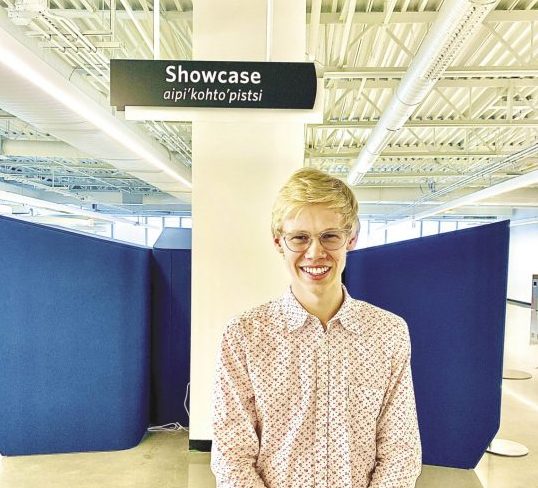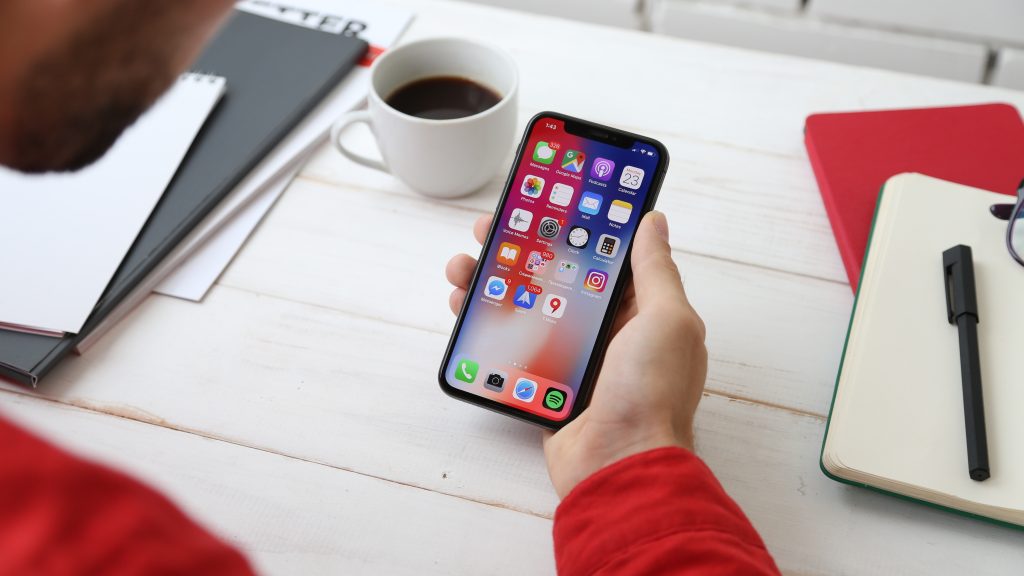MRU student develops app to translate Blackfoot signs

Chase Schrader, student developer of AR app DeciphAR stands in front of Blackfoot wayfinding sign on fourth floor, This sign translates to “Showcase- beloved or treasured, a tiny little window,” says Jessie Loyer. Photo by Ryleigh Stangness
By Ryleigh Stangness, Staff Writer
As Chase Schrader, an MRU student, was gearing up for his co-op placement following the second year of his information design program, he says most students were headed towards doing traditional work in marketing strategies and structural documentation.
One of his classes was brushing the surface on augmented reality tools, when Jessie Loyer, librarian and co-builder of the Riddell Library, presented in one of Schrader’s classes about a project vision they had for the Riddell Library — wayfinding signage.
“We had some money to work on a project,” Loyer explains, who had been part of what she explains as step one, which was to collaborate with Mary Weaslefat, a speaker and librarian at the Red Crow College in Lethbridge and Elder Leo Fox from the Kanai Nation.
They “translated the language and then moved forward with the printed signs,” says Loyer adding these are the Blackfoot wayfinding signs that can be seen marking several locations and collections throughout the Riddell Library and Learning Centre.
Loyer, who is Cree-Métis and a member of Michel First Nation explains, “We are guests on Treaty 7 territory, on Blackfoot territory and language is an important way of acknowledging that.”
However, Loyer adds, “Physical signage has its limitations [and] library signage has its challenges, too. We wanted to avoid the idea of a beautiful art piece — we want to use this language and for people to feel comfortable pronouncing it and not see it as an obstacle.”
The second step of the project would involve finding a way to make these signs interactive. “Blackfoot is a living language,” Loyer adds.
According to the app’s external release, “DeciphAr uses Augmented Reality (AR) to provide audio and visual information about the Blackfoot signage. … The audio information includes the pronunciations of the Blackfoot phrases present on the signs. Also, each Infocard contains an explanation of the translation.”
“Users can scan the signs in the library to access these Infocards. Once [they are] found, the information is accessible through the list. To test their skills, users can try the quiz.”
“I didn’t have to come up with the idea of creating the app,” says Schrader, who is part of the Vizteam at the MRU Library. The team consists of Schrader, Loyer, Anna Nuhn the team’s Emerging Technologies Specialist and Matt Laidlow the interface developer.
“They said, ‘We want to create this, how you do it is up to you, your skills and how you go about that,’” says Schrader. “I really didn’t know what to expect. It was my first job working specifically in the design space before I used to just work retail and then we’re able to do co-op internships and it was my first time in that.”
It was a long stretch, Schrader explains. “Fifteen iterations later, we arrived at something that we felt worked. We launched it on Oct. 10, so five and a bit months of the full development process and iterating to get it to market.”
“It’s just that the learning process of something that is so new, that you’re almost paving the way. That really poses a lot of challenges to us… You can’t go Google, ‘How do you show something to click on something on there?’ You have to be like, ‘Try it and let’s go back to the drawing board.’
“The opportunities that I was able to get from [this project are] very rare — that you’re able to go and put together all these little pieces […] and then to be able to have such an interest after. It’s absolutely incredible. I did not expect it at all.
“Chase is our developer, it’s really neat that it is not developed by an external partner but a student developer and it’s so wonderful to see work on our campus done by exceptional students,” says Loyer.
Loyer hopes this new app takes away a little bit of the obstacle when you see a word you’re not familiar with. We often have this fear of not even trying to attempt speaking another language. Hopefully, this app reduces that fear.
“This takes [Blackfoot language] away from being an exotic or historicized idea and brings language close to home,” says Loyer.
“Cultural appropriation happens when Indigenous people are not part of the process. It should be a collaboration and not an extractive process,” says Loyer.
“The Blackfoot Community College is building a new building since [the original] burned down a few years ago,” Loyer explains. “We are partnering to make sure this app will be available for them, avoiding an extractive process and then not making it available for their consumption.”
She adds this app is not preserving the Blackfoot language, nor meant to teach Blackfoot language, but it is a practical pronunciation tool. “We can do small things and this is a small way of trying to balance out this long history,” says Loyer.
Loyer adds, “Any intervention we can have helps balance out a tiny bit more and one of the ways to do this is through language.”



